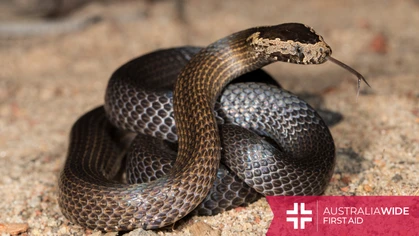5 Most Common Bees in Australia

Bites and Stings

Australia is home to many bee species.
Australia is home to a diverse range of bee species, each playing a crucial role in pollination and ecosystem health. Recognizing the significance of bees' positive impact, it becomes imperative to acquaint ourselves with the various species, distinguishing characteristics, geographical distributions, stinging tendencies, and suitable first aid measures for bee stings. By gaining this knowledge, we can cultivate a deeper understanding of these remarkable creatures, promote harmonious coexistence, and effectively address any encounters that involve bee stings. Being informed about bees and their traits allows us to appreciate their role in nature while ensuring our safety and the preservation of their invaluable contributions.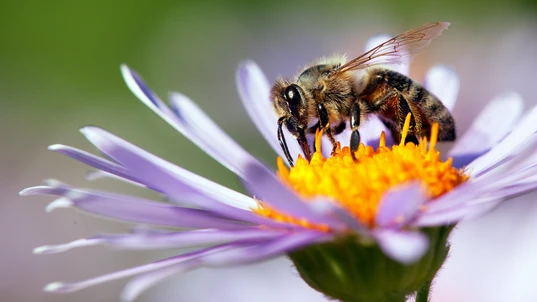
European Honey Bee
European Honey Bee (Apis mellifera)
The European Honey Bee, also known as the Western Honey Bee, is highly recognizable and widely prevalent in Australia. With their distinct yellow and black striped abdomen, measuring approximately 15mm in length, they are a prominent and familiar species in the country. Range/Location: European Honey Bees are primarily found in urban and rural areas across Australia, forming large colonies in hives. Sting Potential: They are generally docile but will sting if they feel threatened
Blue-banded Bees
Blue-banded Bee (Amegilla spp.)
The Blue-banded Bee is a native Australian species known for its distinctive metallic blue bands across its abdomen. These solitary bees measure approximately 12-14mm in length. They are commonly found in urban gardens, parks, and native vegetation areas throughout Australia. Range/Location: They are commonly found in urban gardens, parks, and native vegetation areas throughout Australia. Sting Potential: Unlike European Honey Bees, Blue-banded Bees are not aggressive and rarely sting, even when handled.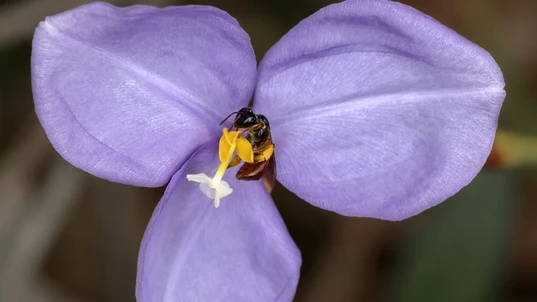
Reed Bee
Reed Bee (Exoneura spp.)
Reed Bees are a diverse group of native Australian bees with over 170 known species. They vary in size, but most are around 5-10mm long. Reed Bees are solitary bees that prefer nesting in hollow plant stems or wood. They are commonly found across different habitats Range/Location: They are commonly found across different habitats, including forests, coastal areas, and suburban gardens. Sting Potential: Reed Bees are generally docile and do not pose a significant threat to humans. They will only sting if directly provoked.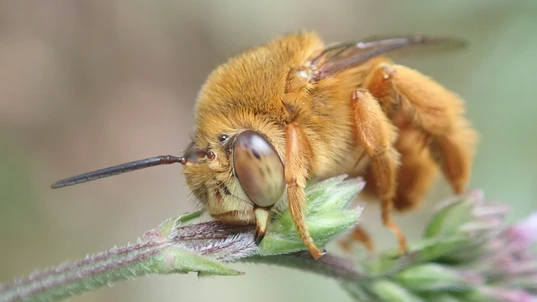
Teddy Bear Bee
Teddy Bear Bee (Amegilla bombiformis)
The Teddy Bear Bee, also known as the Golden-haired Furrow Bee, is a native Australian species. These bees have a furry golden-brown thorax and a black abdomen measuring about 10-12mm in length. They are solitary bees that nest in burrows in the ground or decaying wood. Range/Location: They can be found in various habitats, including coastal areas, woodlands, and urban gardens. Sting Potential: While they rarely sting, Teddy Bear Bees may defend themselves if mishandled.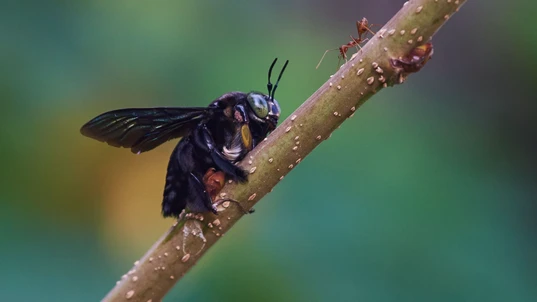
Carpenter Bee
Carpenter Bee (Xylocopa spp.)
Carpenter Bees are large, robust bees with shiny black bodies, measuring around 15-25mm in length. They are commonly mistaken for bumblebees due to their size and appearance. Carpenter Bees, also called solitary bees, have a unique nesting habit as they make their homes in wood. These bees can build their nests in different types of wood, including timber structures and trees that have died. Range/Location: They can be found across Australia, often in forested areas, woodlands, and gardens. Sting Potential: Male Carpenter Bees do not sting, while females have the ability to sting but are not aggressive unless directly provoked.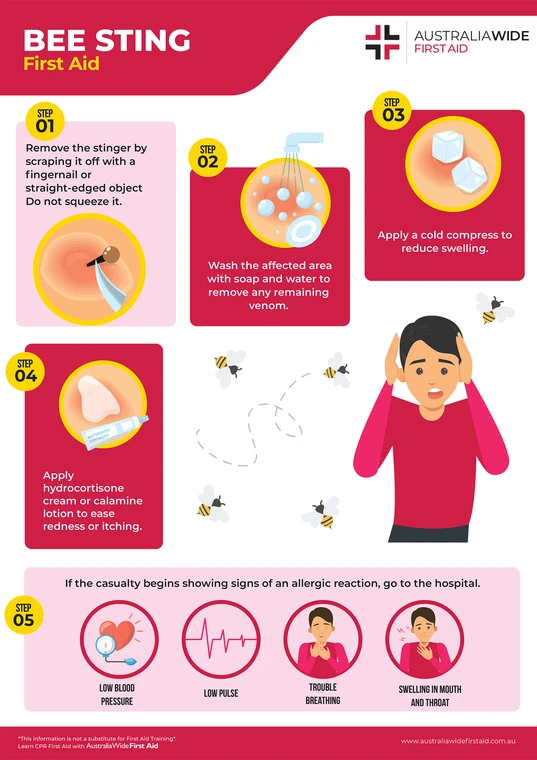
First Aid chart for bee stings
First Aid Treatment for Bee Stings
Bee stings can be a painful and uncomfortable experience, but knowing the appropriate first aid treatment can help alleviate the symptoms and promote faster healing. If you or someone you know has been stung by a bee, it's important to take prompt action. Here are the steps to follow- The first step is to remove the stinger as quickly as possible. Scrape it off using a fingernail, credit card, or a similar object. Do not squeeze the stinger, as it may release more venom.
- To lower the chances of infection, use mild soap and water to clean the impacted region.
- Apply a cold compress for 10 minutes to reduce swelling and discomfort.
- If you're experiencing pain and inflammation, you can take over-the-counter pain relievers like acetaminophen or ibuprofen. Just make sure to follow the dosage instructions on the packaging.
- Applying a topical hydrocortisone cream or calamine lotion may help relieve itching and irritation caused by the sting.
- It's important to resist the urge to scratch the sting site, as it can increase the risk of infection.
- Monitor the person for signs of an allergic reaction. Watch for any severe symptoms such as difficulty breathing, dizziness, or swelling of the face, throat, or tongue. If these symptoms occur, it may indicate an allergic reaction and immediate medical attention is necessary. Call Triple Zero (000) for an ambulance and follow the Australian Resuscitation Council's anaphylaxis treatment guidelines.
Conclusion
Bees are important for the environment because they pollinate and make honey. But it's important to be prepared for bee stings, which can be uncomfortable and cause allergic reactions. Having a basic understanding of bee species, their identification, range or location, and the appropriate first aid treatment for bee stings is especially crucial in regions like Australia, known for its diverse bee populations. By familiarizing ourselves with these aspects, we can coexist harmoniously with bees and respond effectively in the event of a bee sting. It's always advisable to contact local beekeepers or pest control experts if you encounter a swarm or hive that needs to be relocated. They have the expertise and tools to handle the situation safely and responsibly. Additionally, taking first aid courses can be beneficial to gain knowledge on how to deal with people who may have an allergic reaction to bee stings. These courses can also provide a deeper understanding of bees and their nature, allowing for better awareness and preparedness in bee-related situations. Remember, bees are not just pests to be feared but important contributors to our environment. By respecting their presence and taking appropriate precautions, we can coexist with these vital pollinators while ensuring our safety and well-being.
Originally published at
https://www.australiawidefirstaid.com.au/resources/5-most-common-bees-in-australia
as part of the Australia Wide First Aid Articles Library









